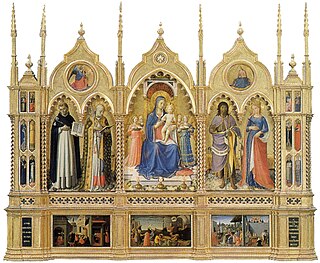
Fra Angelico, OP was a Dominican friar and Italian painter of the Early Renaissance, described by Giorgio Vasari in his Lives of the Artists as having "a rare and perfect talent". He earned his reputation primarily for the series of frescoes he made for his own friary, San Marco, in Florence, then worked in Rome and other cities. All his known work is of religious subjects.

Piero della Francesca was an Italian painter of the Early Renaissance. To contemporaries he was also known as a mathematician and geometer. Nowadays Piero della Francesca is chiefly appreciated for his art. His painting is characterized by its serene humanism, its use of geometric forms and perspective. His most famous work is the cycle of frescoes The History of the True Cross in the church of San Francesco in the Tuscan town of Arezzo.

Domenico Veneziano was an Italian painter of the early Renaissance, active mostly in Perugia and Tuscany.

Luca Signorelli was an Italian Renaissance painter from Cortona, in Tuscany, who was noted in particular for his ability as a draftsman and his use of foreshortening. His massive frescos of the Last Judgment (1499–1503) in Orvieto Cathedral are considered his masterpiece.

Lorenzo di Pietro, known as Vecchietta, was an Italian Sienese School painter, sculptor, goldsmith, and architect of the Renaissance. He is among the artists profiled in Vasari's Le Vite delle più eccellenti pittori, scultori, ed architettori.

Benozzo Gozzoli was an Italian Renaissance painter from Florence. A pupil of Fra Angelico, Gozzoli is best known for a series of murals in the Magi Chapel of the Palazzo Medici-Riccardi, depicting festive, vibrant processions with fine attention to detail and a pronounced International Gothic influence. The chapel's fresco cycle reveals a new Renaissance interest in nature with its realistic depiction of landscapes and vivid human portraits. Gozzoli is considered one of the most prolific fresco painters of his generation. While he was mainly active in Tuscany, he also worked in Umbria and Rome.

Cosimo Rosselli was an Italian painter of the Quattrocento, active mainly in his birthplace of Florence, but also in Pisa earlier in his career and in 1481–82 in the Sistine Chapel in Rome, where he painted some of the large frescoes on the side walls.

Antoniazzo Romano, born Antonio di Benedetto Aquilo degli Aquili was an Italian Early Renaissance painter, the leading figure of the Roman school during the latter part of the 15th century. He "made a speciality of repainting or interpreting older images, or generating new cult images with an archaic flavor", in particular by very often using the gold ground style, which was unusual by this period.
The decade of the 1450s in art involved many significant events, especially in sculpture.
The decade of the 1440s in art involved some significant events.

The Prado Annunciation is an altarpiece painted by Giovanni da Fiesole, known now as Fra Angelico, in the 1420s. It is one of his best-known works and originally destined for the convent of the observant Dominicans of Fiesole, the painting is currently in the collection of the Museo del Prado in Madrid.The work is one of three altarpieces by Fra Angelico representing the Annunciation; the other two being the Cortona Annunciation and the Annunciation of San Giovanni Valdarno. The sequence in which the three works were painted is not certain, but the general art historical consensus places the Prado version first.

The Coronation of the Virgin is a painting of the Coronation of the Virgin by the Italian early Renaissance painter Fra Angelico, executed around 1432. It is now in the Uffizi Gallery of Florence. The artist executed another Coronation of the Virgin, now in the Louvre in Paris.

The Coronation of the Virgin is a painting by the Italian early Renaissance master Fra Angelico, executed around 1434–1435 in Fiesole (Florence). It is now in the Musée du Louvre of Paris, France. The artist executed another Coronation of the Virgin, now in the Uffizi in Florence.

The Perugia Altarpiece is a painting by the Italian early Renaissance painter Fra Angelico, housed in the Galleria Nazionale dell'Umbria of Perugia, Italy.

The Tabernacle of the Linaioli is a marble aedicula designed by Lorenzo Ghiberti, with paintings by Fra Angelico, dating to 1432–1433. It is housed in the National Museum of San Marco, Florence, central Italy.

The St. Peter of Verona Triptych is a tempera-on-panel painting by the Italian early Renaissance master Fra Angelico, executed around 1428–1429. It is housed in the National Museum of San Marco, Florence, region of Tuscany, Italy.

Crucifixion with Mourners and St Dominic is a fresco fragment by the Italian early Renaissance painter Fra Angelico, executed c. 1435, from the refectory of the Convent of San Domenico, Fiesole, now in the Louvre.

The Croce al Tempio Lamentation is a 1436 or 1440 tempera-on-panel painting by Fra Angelico, now in the Museo nazionale di San Marco in Florence. It is named after its commissioner, the 'Compagnia di Santa Maria della Croce al Tempio'.

The Virgin Reliquaries are four 1434 panel paintings by Fra Giovanni Masi after drawings by Fra Angelico, intended as tabernacle-reliquaries for the Convent of Santa Maria Novella. One is in the Isabella Stewart Gardner Museum in Boston whilst the rest are in the Museo nazionale di San Marco in Florence.





















